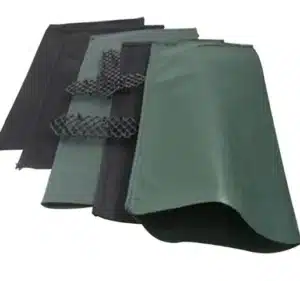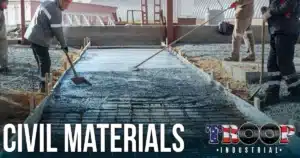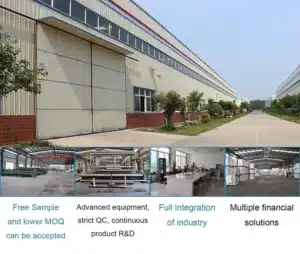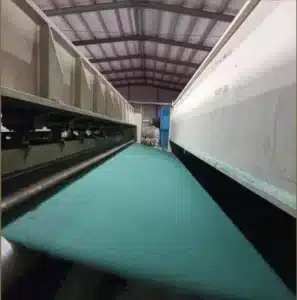Soft ground stalls work. Trucks rut. Aggregate costs rise. You need a simple product that turns weak soils into stable bases fast.
Geocell for road construction is a three-dimensional HDPE honeycomb that confines infill and spreads load. It reduces rutting, cuts base thickness, and speeds programs while keeping tests and documents clear for approval.
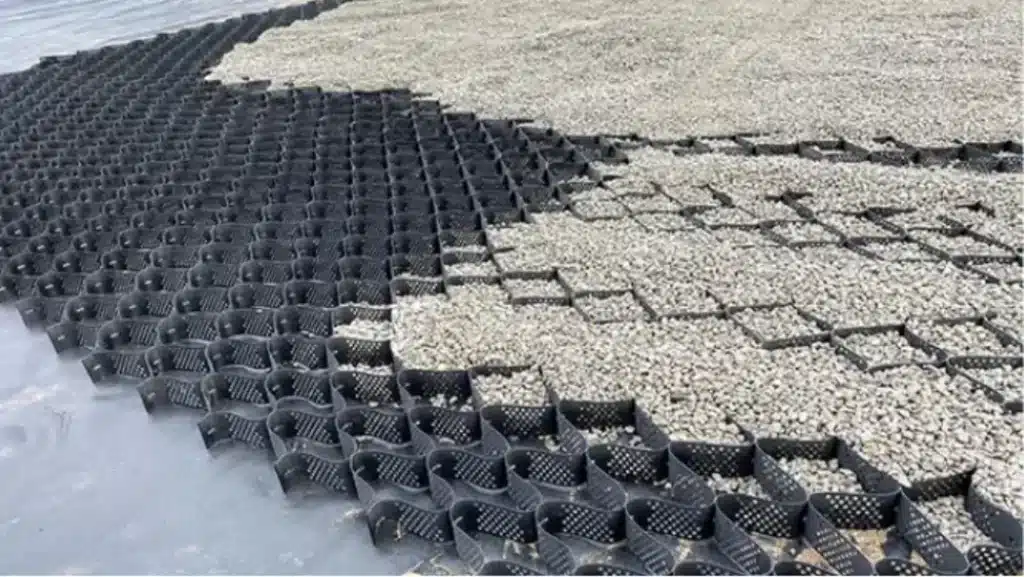
What geocells are?
Road bases fail on weak soils. Fines pump. Ruts grow fast. You want a simple structure that locks infill and resists lateral movement.
Geocells are expandable HDPE panels made from welded strips that form a honeycomb. When filled with aggregate or soil, the cells confine the infill, increase shear resistance, and spread surface loads into the subgrade.
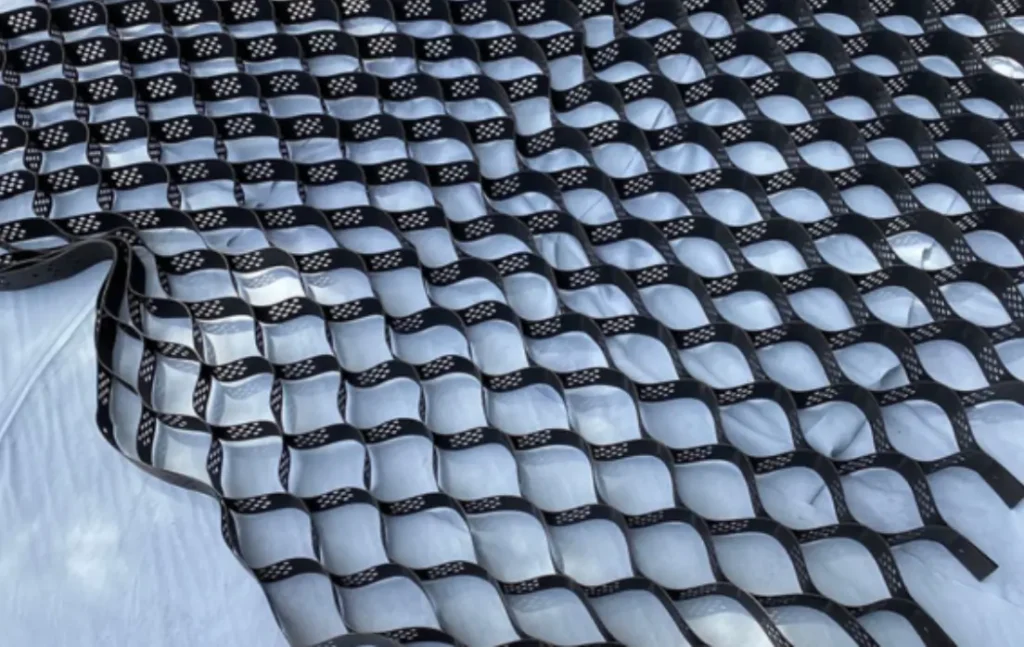
Dive deeper
Core parts
A geocell panel uses HDPE strips with set thickness, texture, and sometimes perforations. Ultrasonic welds join strips at a fixed spacing. The panel ships folded. On site, crews expand it to design dimensions and anchor it to the prepared ground or to a separator geotextile. Cell height and strip thickness set stiffness. Texture raises interface friction. Perforations can help water equalize between cells when design allows for it.
What the honeycomb does
The honeycomb creates three-dimensional confinement. The infill cannot move sideways, so each loaded cell mobilizes hoop tension in the strip walls. The system turns vertical wheel loads into a wider stress bulb in the base and subgrade. The result is lower strain, lower rut, and better bearing for the same base thickness. On very soft ground, taller cells add confinement and let you keep a buildable section.
Where the panel sits in a road section
A typical section from bottom to top is: trimmed subgrade, nonwoven geotextile separator on fines-rich soils, geocell panel, specified infill placed in thin lifts and compacted, and the wearing surface (gravel, chip seal, or asphalt). You can combine the panel with edge drains or geocomposite drains to keep the base dry.
| Element | Role | Buyer checks |
|---|---|---|
| HDPE strips | Confinement | Strip thickness, density, carbon black |
| Ultrasonic welds | Structural integrity | Weld peel/shear strength |
| Texture/perforation | Friction/hydraulic relief | Visual pattern, spec match |
| Cell height | Stiffness & load spread | 100–200 mm typical road range |
| Panel ID/labels | Traceability | Lot, date, dimensions on label |
How does geocell work for road construction?
Weak subgrades deform at low strain. Base spreads load but still moves. You need lateral restraint inside the base itself.
Geocell works by confining aggregate in three dimensions. Confinement mobilizes hoop tension and increases apparent cohesion. Load spreads wider. Rutting drops. Bases can be thinner or longer-lasting.
Dive deeper
Mechanisms in plain language
Three effects matter. First is lateral confinement. The cell walls stop stone from moving sideways, so the base acts stiffer under wheels. Second is the membrane effect. The strip walls carry hoop tension and pass some load to nearby cells. Third is load distribution. The system spreads the wheel load over a larger area of subgrade. Together, these effects reduce strain in soft layers.
What this means for rutting and thickness
You can hold a target rut depth with less aggregate, or you can keep thickness and get a stronger road. On very soft soils, taller cells reduce lateral flow of fines and stabilize the working platform. The gain is often seen in faster compaction, fewer passes, and fewer wet-weather delays. That is why geocell for road construction helps both paved and unpaved roads, yards, forestry tracks, wind farm access, and temporary haul routes.
Design notes you can include
Cell height scales with problem severity: 100–120 mm for moderate soils and light traffic, 150–200 mm for heavy trucks or CBR below about 3–4%. Strip thickness and weld strength set panel stiffness and durability. Texture improves friction between infill and cell wall, which reduces slippage under braking or on grades. Perforations can help equalize pore water between cells but must match soil and drainage design.
| Mechanism | Result | Field sign |
|---|---|---|
| Confinement | Higher base stiffness | Lower deflection under LWD/plate |
| Hoop tension | Load sharing | Fewer localized ruts |
| Load spread | Wider stress bulb | Better performance on soft spots |
| Interface friction | Less shear slip | More stable grades/ramps |
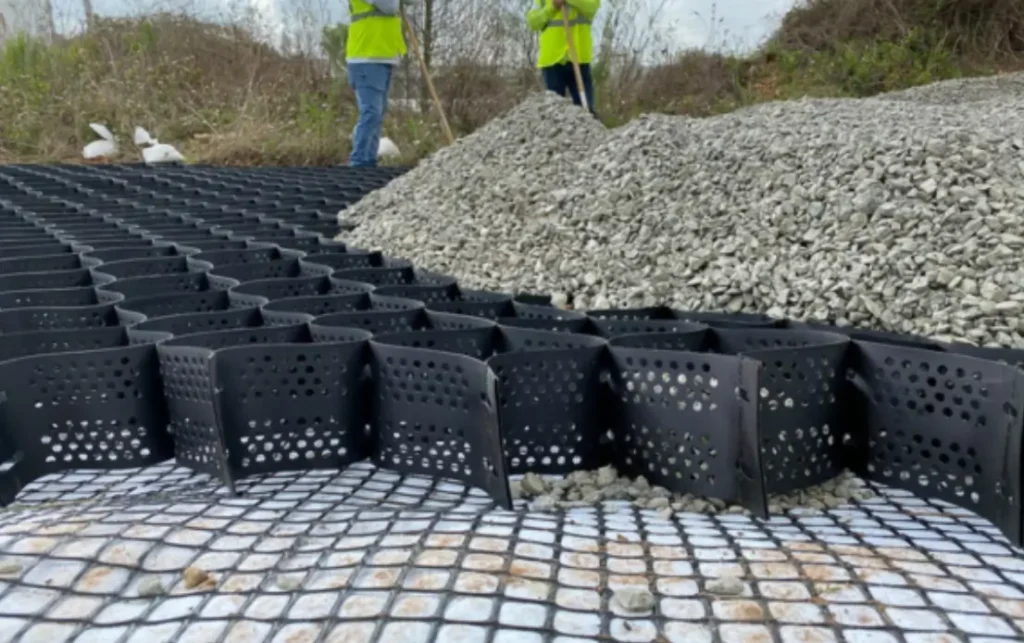
How to choose the right geocell for road construction?
Too many options slow buying. You want a short path from soil data to SKU with tests you can accept on site.
Choose by subgrade strength, traffic class, gradient, climate, and infill. Lock cell height and strip thickness. Decide on texture and perforation. Add a separator geotextile for fines-rich soils and include drainage.
Dive deeper
Inputs you need
Get a CBR value or a quick field proxy like DCP blows per 100 mm or LWD modulus. List traffic: cars only, mixed deliveries, or heavy trucks. Note grades and curves. Record rainfall and freeze–thaw risk. Confirm available infill: crushed stone, sand, or recycled aggregate. With these inputs, you can pick cell height and decide if you need texture and perforations.
Simple matrix that works
| Subgrade (CBR) | Traffic | Suggested cell height | Notes |
|---|---|---|---|
| ≥5% | Cars/light trucks | 100–120 mm | Optional texture; separator on clays |
| 3–5% | Mixed deliveries | 120–150 mm | Use nonwoven separator; add edge drains |
| 1–3% | Heavy trucks | 150–200 mm | Consider textured strips; stricter compaction |
| <1% | Very soft | 200 mm + staged | Engineer platforms; hybrid with geogrid in lanes |
Strip thickness controls panel stiffness and handling. Heavier strips resist damage and creep. Texture raises friction where braking and turning loads are high. Perforations can help with water equalization when your design allows for it and fines risk is managed with a separator.
Documents to ask for in the PO
Ask for lot-level COA/CQC showing strip thickness statistics, weld strength, resin data, and carbon black content and dispersion. Ask for panel labels with lot and date. Ask for peel/shear test reports for the welds. If you combine geocell with geotextiles or drains, ask for those certificates too. Clear documents speed submittals and protect handover.
| Item | Minimum you should see |
|---|---|
| Strip thickness | Mean and tolerance band |
| Weld strength | Peel/shear per lot |
| Resin & UV | Density, carbon black %, dispersion |
| Panel geometry | Cell size, height, panel dimensions |
| Labels & trace | Lot/date on every pallet and panel |
When should you use geocell instead of other solutions?
Many tools exist. Geotextiles separate. Geogrids reinforce in two dimensions. Cement stabilization hardens soil. You want to know where geocell is the cleaner choice.
Use geocell when subgrade is very soft, grades are steep, or you need to use local or recycled infill. Use it when you want a thin section and a fast build with simple tests.
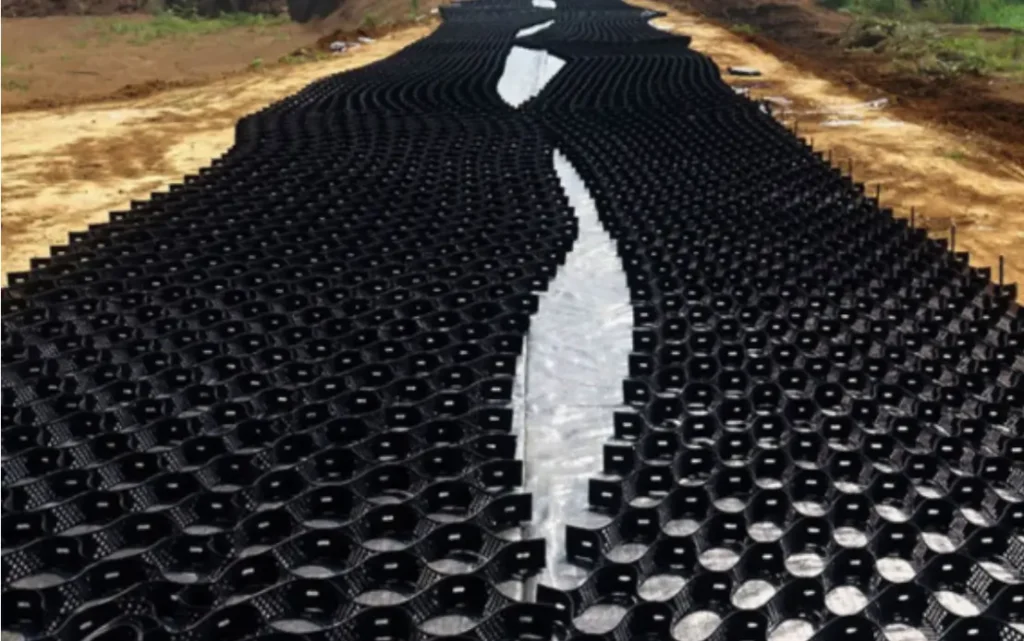
Dive deeper
Compare roles in one view
A nonwoven geotextile gives separation and filtration. It stops fines from pumping into the base. A biaxial geogrid improves interlock with angular stone, which boosts stiffness at small strain. A geocell adds confinement in the third dimension, so the base acts as a reinforced layer with higher shear resistance. Chemical stabilization can still help in some soils, but it adds cure time, moisture control, and permits.
Triggers for geocell
Use geocell when CBR is below about 3–4% and trucks must run early. Use it on ramps, hairpins, and braking zones where shear is high. Use it where you need to minimize imported stone, like remote sites or wetlands with strict haul limits. Use it when recycled concrete aggregate or marginal fills are the only economic option. Confinement makes these materials act better than they would in an unconfined base.
Hybrid sections that work
You can pair a separator geotextile with geocell in almost all fines-rich soils. You can add a biaxial geogrid under the geocell in wheel paths on very soft subgrades if design calls for it. You can add geocomposite edge drains to keep the base dry. Each added layer should serve a clear function with a test attached.
| Problem | Best tool | Why |
|---|---|---|
| Fines pumping | Nonwoven geotextile | Separation and filtration |
| Moderate rutting | Biaxial geogrid | 2D interlock raises stiffness |
| Severe rutting/soft subgrade | Geocell | 3D confinement and load spread |
| Need thin section | Geocell | Higher stiffness per thickness |
| Only local/recycled fill | Geocell | Confinement upgrades material behavior |
What installation and QA/QC should buyers require?
Supply is only half. Field practice writes the warranty story. You want short rules that crews can follow and inspectors can sign.
Require subgrade sign-off, separator on fines-rich soils, correct panel expansion and anchorage, lift thickness limits, compaction targets, and drainage. Accept only with photos, panel IDs, and quick field tests.
Dive deeper
Ground and layer order
Trim the subgrade. Remove sharp objects. Proof-roll and mark soft spots. Use a nonwoven geotextile separator on clays and silts. Lay panels aligned with the road centerline. Anchor per method statement. Connect panels with joiners or staples per design. Keep the base crown or crossfall so water exits.
Infill and compaction
Place infill in thin lifts across the expanded cells. Do not drive on empty cells. Use vibratory compaction matched to your aggregate and moisture window. Keep moisture in range so lifts densify without pumping. Maintain even infill level so cells do not twist or bridge. Keep edge containment stable until the wearing course locks the section.
Records and acceptance
Keep panel IDs and lot numbers in a simple map. Take photos before, during, and after infill. Run LWD or plate load checks at set intervals. Log density or proof-roll passes by chainage. Keep drain outlets open and mapped. Deliver an as-built pack with labels, test results, panel map, and photos. This set closes out payment milestones without delay.
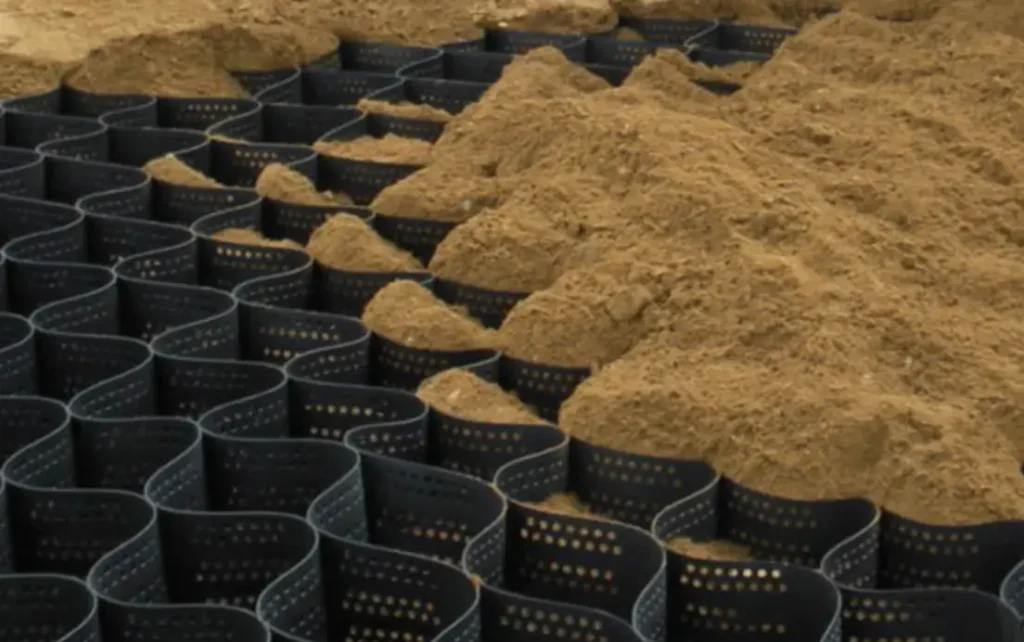
| Checkpoint | Pass rule |
|---|---|
| Subgrade | Proof-roll recorded; soft spots treated |
| Separator | AOS and permittivity match spec; overlaps 300–500 mm |
| Panel | Height and cell size match; anchors per plan |
| Infill | Gradation as approved; moisture in range |
| Compaction | Target density or LWD modulus reached |
| Drainage | Edge drains installed; outlets protected |
| Records | Panel map, photos, test logs complete |
What tests and specifications define a quality road geocell?
Promises do not pass audits. You need numbers and documents that match your lot and your site.
Specify strip thickness, weld strength, texture/perforation pattern, cell height, and panel geometry. Ask for COA/CQC per lot, resin data, carbon black and dispersion, and weld peel/shear results.
Dive deeper
Factory tests
Strip thickness controls stiffness. Weld peel/shear proves joint integrity. Density and ESCR indicate resin quality. Carbon black at about 2–3% with Class 1 dispersion protects against UV. Texture pattern and perforation spacing must match drawings. Panels should carry printed IDs for traceability. A good supplier will share sampling frequency and acceptance criteria.
Field and interface tests
If you place geocell on a liner or on steep grades, ask for interface shear data for your exact pair of materials. If drainage matters, specify edge drains and show transmissivity targets for any geocomposite drains you include. For acceptance in roads, many buyers use LWD modulus targets tied to rut depth goals. Keep units and values fixed in the spec to avoid debates.
A short spec paragraph you can adapt
Geocell panels shall be HDPE, cell height 150 mm, strip thickness 1.5 mm nominal (±10%), textured, non-perforated unless noted. Welds shall meet minimum peel strength of X N/10 cm and shear strength of Y N/10 cm. Provide COA per lot for strip thickness, weld strength, density, carbon black content and dispersion. Panels shall be labeled with product code, lot, date, and dimensions. Provide interface shear data where panels sit over liners or steep grades.
| Property | Typical range | Why it matters |
|---|---|---|
| Strip thickness | 1.1–1.7 mm | Stiffness and creep resistance |
| Cell height | 100–200 mm | Confinement and load spread |
| Weld strength | Project-specific | Joint integrity under cyclic loads |
| Carbon black | 2–3% | UV protection |
| Texture | As specified | Friction and shear resistance |
What mistakes should buyers avoid with geocell roads?
Good product fails with bad details. You want a short list of traps and the fixes.
Avoid missing separators on clays. Avoid poor drainage. Avoid driving on empty cells. Avoid vague specs without tests. Avoid skipping as-built records and photos.
Dive deeper
Typical errors and impacts
No separator on fines-rich subgrade allows pumping, so the base clogs and ruts. Poor drainage traps water, so loads rise and stiffness falls. Driving on empty cells twists panels and weakens welds. Vague specs let substitutions in that do not meet the function. Missing photos and maps extend disputes and delay payment.
Fixes that stay simple
Add a nonwoven separator with AOS and permittivity that match your soil. Keep crown or crossfall and install edge drains that lead to protected outlets. Place infill in thin lifts and compact from the edges inward. Write specs with two or three named tests for each function. Require lot-level COA and a complete as-built pack.
Short do/don’t table
| Do | Don’t |
|---|---|
| Use separator on clays and silts | Place geocell directly on pumping fines |
| Keep drainage open | Trap water above barriers or behind edges |
| Compact in thin lifts | Overfill and bridge cells |
| Map panels and tests | Rely on memory during handover |
| Name tests in PO | Accept brochures without numbers |
My opinion
Function comes first. Tests come second. Brand comes last. When you buy geocell for road construction this way, you buy performance, not promises. I suggest small, standard SKU sets by soil and traffic class, each with fixed acceptance tests and documents. I suggest pairing with a separator and drains on most fines-rich sites. I suggest early submittals with lot-level COA/CQC and a simple as-built template so your closeout is smooth.
FAQ
Q1: Is geocell only for unpaved roads?
A1: No. It also sits under chip seal or asphalt to reduce base thickness or extend life.
Q2: Which cell height should I pick?
A2: Use 100–120 mm for better soils and light traffic, 120–150 mm for mixed deliveries, 150–200 mm for heavy trucks or CBR below about 3–4%.
Q3: Do perforations always help?
A3: Not always. They can equalize water between cells. On fines-rich soils, control migration with a separator and use perforations only when design supports it.
Q4: What infill works best?
A4: Angular, well-graded crushed stone compacts well and interlocks. Recycled concrete aggregate can work inside cells when gradation and moisture are controlled.
Q5: Which documents should I demand?
A5: COA/CQC per lot for strip thickness, weld strength, density, carbon black/dispersion, plus panel labels. Keep LWD, DCP, and photo records in your as-built pack.
Conclusion
Pick cell height from soil and traffic, keep drainage and separation tight, and tie acceptance to a few clear tests. Geocell for road construction then delivers fast builds and low rutting.

